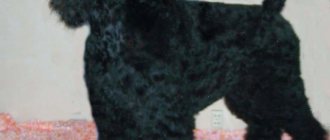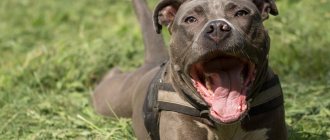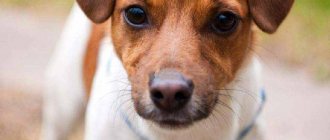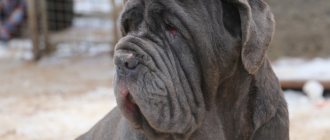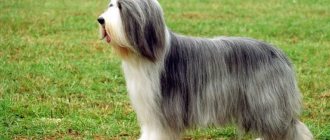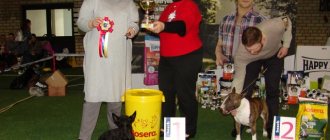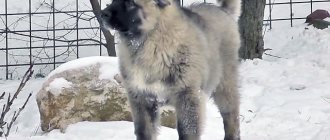Breed traits
Breed traits (on a 5-point scale)
| Lakeland Terrier | |||
| Activity | in the house | 4.3 | |
| on the street | 4.3 | ||
| Obedience | training | 2.8 | |
| strangers | 3.3 | ||
| Domination | in family | 2.3 | |
| over dogs | 3.8 | ||
| Defending your territory | from people | 2.3 | |
| from dogs | 3.5 | ||
| Sociability | in family | 4.8 | |
| with strangers | 3.8 | ||
| with dogs | 2.8 | ||
| Concentration | in family | 2.3 | |
| in front of strangers | 2.8 | ||
| with dogs | 2.3 | ||
| Aggressiveness | in family | 1.5 | |
| to strangers | 2.3 | ||
| to the dogs | 3.5 | ||
| to cats | 3 | ||
| Family behavior | calmness | 3.8 | |
| demand for affection | 3 | ||
| excitability | 4.8 | ||
| playfulness | 5 | ||
| excessive barking | 3.3 | ||
| behavioral breakdowns | 2.5 | ||
| Tolerance for children | up to 4 years | 4 | |
| over 4 years old | 4.3 | ||
| Institutional use | watchman | 3.8 | |
| bodyguard | 2.3 | ||
This breed is often compared to the following dog breeds: Welsh Terrier, Wirehaired Fox Terrier, Airedale Terrier, Irish Soft Coated Wheaten Terrier (Whiten Terrier), Miniature Schnauzer (Dwarf Schnauzer).
Pictured are Lakeland Terriers:
General characteristics of the Lakeland Terrier breed
This breed was formerly called the Patterdale Terrier. The name “Lakeland Terrier” appeared only in the 20th century and is translated as “Lakeland Terrier”. These are medium-sized dogs, one of the terrier varieties. They were bred to protect farms from rodents and to hunt burrowing animals.
Externally, these dogs are similar to Airedale Terriers and Welsh Terriers. Lakelands differ from them in growth and temperament. They have a less massive build and high legs, thanks to which they can develop greater speed. Unlike Welsh Terriers, they are almost non-aggressive, people-oriented, and easier to train.
| Options | Characteristic |
| breed name | Lakeland Terrier |
| a country | Great Britain |
| breed group | terriers |
| application | hunting, sports, companions |
| life expectancy | 12-15 years |
| height | up to 37 cm |
| weight | up to 8 kg |
| character traits | cheerfulness, excitement, fearlessness, friendliness, devotion |
| appearance features | strong build, high legs, rectangular muzzle, hard, dense coat |
| colors | black and tan, blue, saddle cloth, grizzly, wheaten |
| aggression | average |
| activity | high |
pros
Due to their small size, Lakeland Terriers easily get along in a city apartment. They are unpretentious, their fur hardly sheds, does not emit a dog smell and does not cause allergies. This dog is perfect for an active owner; it will accompany him on hikes and enjoys playing sports. Representatives of the breed are person-oriented and sense their mood. They have several more advantages:
- good guard qualities;
- easy to train, suitable for inexperienced owners;
- sociable, cheerful;
- loyal, attached to the owner;
- vigilant, discerning;
- smart and quick-witted;
- hardy, efficient.
Minuses
But Lakeland Terriers are hunting dogs. They were specially bred to kill rodents. This left an imprint on their character and behavior. Most of the disadvantages of the breed are associated with these features:
- they chase birds and cats on the street;
- do not get along with other pets, especially rodents;
- need high physical activity;
- cannot tolerate loneliness and lack of attention;
- bark a lot;
- often conflict with other dogs.
Pros and cons of the breed
Each dog has a set of individual qualities, but there are those that are inherent to the breed as a whole. The main advantages and disadvantages of the Lakeland Terrier are presented in the table:
| pros | Minuses |
| Almost complete absence of shedding | Friendly with children, but can be dangerous due to its activity and physical strength |
| Has excellent security and watchdog qualities | Not very friendly with other animals, can suppress smaller relatives |
| Easily trainable | Requires constant physical activity |
| Easy to care for | |
| Possibility of living in an apartment | |
| Will be happy to do agility |
History of the origin of the Lakeland Terrier breed
The breed was developed in the rocky terrain of the Lake District. Farmers needed a compact and hardy dog that could crawl into narrow holes and crevices and run over boulders. But she also had to be strong and fearless in order to resist the foxes, from whose raids the farms suffered. To achieve this, dog breeders began to cross different types of terriers: Bedlington, Dandie Dinmont, Wirehaired Black and Tan, Border, Fox Terrier. The longest-legged and narrow-chested individuals were selected. They were dexterous, jumping, and passionate.
At first these dogs were called Patterdale Terriers. They were popular in peasant farms and were used for burrow hunting. In 1912, the first breed club was created, and dogs began to participate in exhibitions. After some time, the breed was officially recognized and called the Lakeland Terrier. By the middle of the 20th century, these dogs spread throughout the world and became popular. But they appeared in Russia only in 1998. This breed is still little known in our country.
Where can I buy
Kennels breeding Lakeland Terriers are few in Russia. Among them are: From Yeseninskaya Grove (Ryazan), Cherished Dream (Saratov), Rus Terrier Cardinal (Moscow). The average price for puppies is 35,000-40,000 rubles, but can be higher.
With proper training, the Lakeland Terrier will become a wonderful friend for any family. Brave, loyal, smart, he will be a good companion and reliable watchman. The main thing is to approach his training wisely and give your pet enough attention.
Appearance of the Lakeland Terrier
Lakeland Terrier dogs have a lean, wiry build. They have long legs and dense, coarse fur. They are classified as medium terriers, but unlike most representatives of these breeds, their height does not exceed 37 cm. They weigh on average 6-8 kg, regardless of gender.
Head
The head is medium in size, the muzzle is rectangular, not long. The skull is flat, moderately wide. The stop is almost invisible. The lobe is large and black. If the color is shabby or wheaten, a brown nose is allowed. The jaws are powerful, capable of holding a fox or otter. The teeth are large, scissor bite.
The eyes are small, oval, widely set. The color of the iris is dark. The look is inquisitive, cheerful. The ears are small, set high and quite close to each other. They are V-shaped, raised at the base, and hanging from the middle. The tips of the ears reach the outer corners of the eyes, the inner edge is pressed to the head.
Frame
The body is proportionally folded, square format. The neck is long, goes into steep withers, without dewlap or folds. The back is short, flat, the chest is narrow, deep, the stomach is slightly tucked. Thanks to this, the dog can fit into any gap that the head fits through. The tail is set high, usually carried vertically, with a slight bend. It is customary to dock it, but not short. The tail should not curl over the back or droop down.
Limbs
The limbs are long and muscular. The front ones are straight, set vertically. The shoulders are laid back, the shoulder blades are located close to each other. The hindquarters are muscular, strong, laid back. The ischial tuberosities and joints are well defined. The paws are small, rounded, the toes are arched, with thick pads. The dog is agile, runs fast, and is able to overcome difficult places.
Wool
Lakeland Terriers have a hard coat and a soft, dense undercoat. The outer hair is straight, coarse, wiry, 2-3 cm long. On the face and limbs the hair is thicker. There it may curl slightly. The legs are profusely pubescent, and the head has a characteristic bang and beard.
Colors
The standard for this breed allows different types of colors. They can be plain or with a saddle. The most common solid colors:
- ginger;
- wheat;
- black;
- blue;
- hepatic;
- grizzly.
Dogs of any color can have a saddle or dark back. Only dark brown or brownish-red colors are not allowed. White spots are not desirable.
Photos complement the description of the appearance:
Character traits
The character and temperament of Lakelands is typical of terriers. These are active, easily excitable, mobile dogs. They are gambling and love active games. A strong hunting instinct makes them run outside after birds and small animals. They often conflict with other dogs, trying to prove their superiority. They do not get along with any pets.
But unlike other hunting dogs, Lakelands do not show aggression towards humans. They become strongly attached to their owner and family members, affectionate and obedient. They easily adapt to the lifestyle and character of the owner, and are suitable for any person who will pay attention to them and provide physical activity. These are pets who love when people pay attention to them and praise them, but they do not impose themselves or get into your hands. They cannot stand loneliness or change of owner, and may even get sick.
Lakelands love children and support all games. This is an excellent family dog, but it will not be a nanny; it is better to get one if the child is older than 3-5 years. The dog will not tolerate being dragged by the tail and ears or having his toys taken away. Therefore, it is necessary to explain to the child the rules of communication with a dog.
These terriers are mischievous, cheerful, love to play pranks and run. They are very addicted, which can make training difficult. But they have a strong territorial instinct and protective qualities. They are vigilant and are wary of strangers, although without aggression. But they always warn the owner by barking about the approach of strangers and about danger.
The Lakeland Terrier is a dog with the following character traits:
- fearless;
- cheerful;
- gambling;
- self-confident;
- purposeful
Education and training
Representatives of this breed are very smart and quick-witted. Therefore, they easily learn different commands and can learn tricks. But training may be difficult due to the active temperament and curiosity of the dog. She is often distracted and can be stubborn, so you need to be patient and persistent. You should never yell at your pet, much less hit him. Positive results in education can only be achieved with affection and encouragement.
Lakeland needs to be socialized from an early age, accustomed to street noise, strangers, and strange dogs. Training should be short and interesting. It is recommended to conduct them in the form of a game. Terriers do not tolerate coercion, monotony, or frequent repetition of one command. Another feature of representatives of this breed is that they are owners. Therefore, you should not wean them from protecting their toys or place.
Character
Representatives of this breed are considered cheerful and energetic, always ready for active games. But they have a strong hunter’s memory, which is why the pet can sometimes get too carried away and turn a fun game into a real hunt. This, of course, does not threaten people, but it can affect other pets, especially if they are small rodents. In this case, it is worth accustoming the dog to a pet for a long time and not leaving them together unattended.
The Lakeland Terrier has a mischievous character. The pet needs constant movement and is easily drawn into play. But he can be extremely serious when it comes to strangers. Dogs are vigilant and wary of them, thanks to which they can be not only wonderful hunters, but also watchmen. The Lakeland Terrier will love its owners very much, since the animal is loyal and affectionate by nature. Therefore, the owners of this dog should remember that they should not give it to someone, especially if the dog has been living in the family for a long time. Representatives of the breed do not tolerate separation well, and a change of owner can even plunge them into deep depression.
Lakeland Terriers are recommended for people who already have experience raising dogs. Without proper training, pets can develop behavioral problems.
Maintenance and care
Lakeland Terriers are very active dogs. They are ready to run all day long and love outdoor games. Due to their small size, they can be kept in a city apartment or private house, but it is necessary to provide them with sufficient physical activity. It is advisable to take them for walks in the park more often, go to the river, and take them to dog parks. This dog will be happy to accompany you on a hike, a car trip, or accompany a bicycle.
Caring for representatives of this breed is easy. The coat hardly sheds, but like other wire-haired terriers it needs trimming. It is done from 6 months of age every 2-3 months.
Otherwise, your pet will require the following hygiene procedures:
- Brush the coat 2-4 times a week with a stiff brush or a fine-toothed metal comb;
- bathe the dog 1-2 times a month using special shampoos;
- Wash or wipe paws after every walk;
- the muzzle needs to be washed after every meal;
- It is recommended to regularly trim the hairs along the contour of the lips and on the paws;
- examine and clean your ears once a week;
- wipe your eyes daily;
- shorten claws every month;
- brush your teeth several times a week with a special paste or give chewy treats;
- Regularly treat the wool with antiparasitic agents.
Nutrition
Breeders recommend feeding the Lakeland Terrier with ready-made food. You need to choose those that are designed for active dogs. It is important that they are not lower than premium class.
With a natural diet, your pet should be given at least 250 g of lean meat every day. It is supplemented with cereals and vegetables. It is useful to give kefir, cottage cheese, eggs, vegetable oil, and herbs. On the recommendation of a veterinarian, vitamin complexes are added to food.
Health
Lakeland Terriers are in good health. With proper care, they live up to 15-16 years. Only occasionally do representatives of the breed experience the following diseases:
- joint dysplasia;
- cataract;
- hypothyroidism;
- blood clotting disorder.
How to buy a Lakeland Terrier puppy
This breed is not very popular in Russia, but you can find kennels in Moscow and other large cities. It is recommended to reserve your puppy in advance as there may be a waiting list. A purebred dog in a good kennel costs 40-50 thousand rubles. Only puppies without a pedigree are sold cheaper.
When choosing, you need to pay attention to the breed characteristics, activity of the puppy and its state of health. There should be no discharge from the eyes, dandruff, or a bloated stomach. A healthy baby has a moist nose, no unpleasant odor, and stands confidently on his feet.
The photo shows what the puppies look like:
An interesting video complements the description of the breed:
Video: Lakeland Terrier. Breed characteristics, care
Lakeland Terriers are loyal companions, mischievous and cheerful pets. They are unpretentious, easy to train and do not show aggression. But this dog should become a member of the family, it needs to be given enough attention, then it will be obedient and will not cause problems.
How to avoid getting scammed
When buying, they often deceive - they slip in beautiful photographs, replace puppies, falsify documents. A common scheme is with a deposit, when the seller requires it to be transferred to the card. The dog may not be vaccinated, check the vaccination records. Carefully examine the dog and check the documents, do not give the money in advance, even partially.
Take the Attention Test! Find 10 differences! (click right here!)
Find the answer Are you bothered by some problem or question? Enter “Breed” or “Name of the problem” into the form, press Enter and you will find out everything about the issue that interests you.
